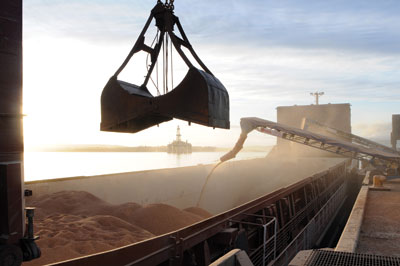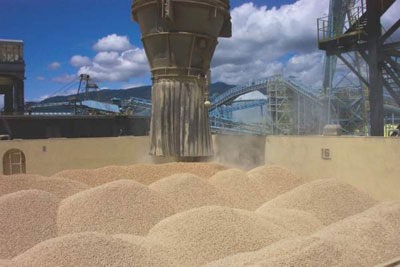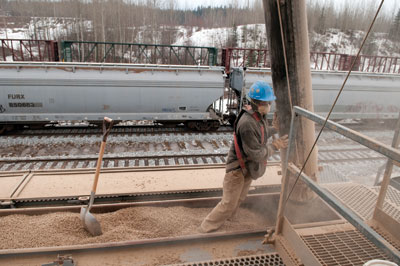
Bulk Pellet Behaviour
April 1, 2011
By Micheal Curci
Numerous wood pellet mills are in development or under construction these days.
Numerous wood pellet mills are in development or under construction these days. With all the mills being constructed, and with most companies focusing on the pellet production and wood procurement processes, the storage of the finished product is often almost an afterthought.

|
|
| A ship’s hold is loaded with wood pellets at the Saltburn Pier in Invergordon, Scotland. Photo: Andrew Duke/HIE |
However, resin in the form of sugars and organic compounds remains in the wood throughout the pellet production process; these compounds can begin to break down during the storage and shipping process, leading to dangerous off-gassing and self-heating. Companies can ensure the best product is delivered to their customers overseas by using enhanced procurement procedures and specific production techniques and by understanding the mechanics and physics of modern pellet storage management. All three of these areas must be taken into consideration when developing a facility. If not properly managed, off-gassing and pellet self-heating start with the procurement of the wood and continue throughout production, shipping, and storage.
Across the pellet industry, it is normal practice to procure the cheapest feedstock for pelletizing without compromising pellet quality. In addition to sawdust, pellet producers use tops, trimmings, and whole-tree chips to reduce overall operating costs because feedstock is the highest cost, normally averaging 40–50% of total production cost. The chemical composition of juvenile and mature wood differs. It is impractical to procure mature wood because lumber mills are competing for that material, so pulpwood is the main source for pellet mills.
A solution for reducing later off-gassing and self-heating currently being tested is aging or drying of the wood once it is cut. The rationale behind this idea is that wood tends to have variable moisture content throughout the year. Allowing the wood to age in the yard prior to processing would allow the wood to begin the natural drying process; therefore, lower drying temperatures would be needed to achieve 8–9.5% moisture content of fibre prior to pelletizing.
Allowing the wood to dry naturally before debarking and chipping would reduce chemical breakdown during chip pile storage as well. Spontaneous heating in wood chip and sawdust piles is caused by oxidation of unsaturated fatty acids and other extractives1. Mills that acquire feedstock and unload and chip it without storing it first are putting chips with average moisture content of 40–48% into their piles, which will increase the chances of both spontaneous heating and chemical breakdown prior to processing.
Hazardous off-gassing
Pellet mills throughout the world use different methods to process feedstock once it is chipped. For instance, one mill may produce three-quarter-inch pine chips that move through a single-pass dryer and into a storage silo until a hammermill pulverizes the strand to a smaller size that is sometimes determined by the end-user contract for particle distribution for co-firing. Another mill may produce half-inch, mixed hardwood chips that pass through a hammermill, then a triple-pass dryer, and then another hammermill to further reduce the strand size to meet the specs of the end-user contract. With each process the wood passes through, the strand structure is altered.
 |
|
| Long-distance shipping of wood pellets, from North America to Europe, for example, can create conditions for carbon monoxide release and oxygen depletion.
|
Research on the effects of processing on the condition of chips shows that the chemical composition changes as a function of refining actions.2
Drying temperature is correlated strongly with the volatile organic compounds (VOCs) emitted from stored pellets, along with pellet self-heating. The major constituents of VOCs emitted from wood pellets are aldehydes, some of which are upper airway irritants. The drying gas temperature is the only significant factor for aldehydes/ketone emissions. Some believe that high drying temperature removes more of the VOCs from the wood prior to pelletizing; however, others believe that high drying temperature actually opens the cellular structure, which, once pelletized, begins to emit more VOCs than what would have been emitted otherwise. High drying temperatures are used to maintain high throughput while reducing moisture content. Lower drying temperatures usually have lower throughput, but the wood emits fewer VOCs and could possibly have reduced VOC emission and self-heating in storage.
An analysis of VOCs emitted from fresh and stored Norway spruce and Scots pine during storage found that unsaturated fatty acids are the leading raw materials of emitted VOCs.3 Aldehydes such as pentanal and hexanal are major constituents of the off-gas, but the amount and composition of emitted substances is affected by drying temperature of the raw material and self-heating of pellet stocks. Spruce and stored pine sawdust contain less fatty acid, which should generate fewer aldehydes. The study’s authors hypothesized that it might be possible to reduce emissions from pellets in storage by optimizing the drying temperature and other process parameters such as wood aging and raw material mixes.
Wood pellet storage and shipping have come under the spotlight since two fatal accidents plus serious injuries in 2002 and 2006 while off-loading pellets shipped overseas from British Columbia to Europe. A typical shipping vessel can carry 30,000 tonnes of pellets at a time, and a typical port storage facility can store as much as 100,000 tonnes in a single facility.
Temperature effects
All biomass gradually decomposes over time, releasing toxic and oxygen-depleting gases such as carbon monoxide (CO), carbon dioxide (CO2), and methane (CH4). Emissions from wood pellets during storage comprise one-carbon compounds such as CO, methanol, formic acid, and formaldehyde, as well as multi-carbon aldehydes such as hexanal and pentanal.4 The oxidation of fatty acids and other components in the wood is the likely cause. The oxidation processes occur below room temperature but are accelerated by elevated temperature.

|
|
| Bulk pellets are sealed in the cargo hold of transoceanic ships, and proper safety procedures have been developed for unloading at the shipment’s destination. Photo: Pacific Bioenergy |
In a conventional biomass composting system, CH4 generation is usually associated with anaerobic decomposition of biomass, whereas CO2 likely is generated from the thermal oxidation of aerobic degradation products. A high temperature favours a high CO/CO2 ratio. As the temperature rises, both CH4 and CO2 emissions increase, with CH4 generation favoured over CO2 at higher temperatures.5
Minimizing problems
The problem with pellets heating up or off-gassing is noticed during shipping or bulk storage. Many different types of storage facilities exist for wood pellets, from cylindrical silos like those used to store grains to warehouse-type facilities in which pellets are loaded by conveyor and removed by a loader. Extensive research has been conducted on the storage of grains in different types of vessels in different climates; however, very little research has been conducted on wood pellet storage. What has been done has been in closed or sealed containers because of costs and other limiting factors on testing. Research to date indicates that ambient temperature is the number one factor for off-gassing and self-heating. Nothing can be done to control ambient temperature, so work must be done to control the temperature within the environment where the pellets are stored. This can be done in several ways but must be considered first prior to building a facility, and not as an afterthought.
 |
|
| Short-term transit of pellets, for example, in railcars from the plant to port, presents less risk of off-gassing and self-heating than does long-distance shipping. Photo: Pacific Bioenergy |
Aeration, also known as active, mechanical, low-volume, or forced ventilation, can be defined as the forced movement of ambient air through bulk product for improvement of storability. The objectives of pellet aeration can be best described as: cooling pellets, equalizing temperatures throughout the pellets, preventing biological heating in damp pellets, circulating off-gasses, and removing odours created by off-gasses. Pellet aeration also helps prevent moisture migration and headspace water condensation in humid climates. Rates of chemical deterioration are very slow and sometimes insignificant at low temperatures, and increase significantly with each 10ºC increase in temperature. Therefore, maintaining low temperatures in the pellets is essential.
Ambient air temperature, solar radiation, atmospheric weather changes that result in major barometric pressure fluctuations, and storage structure parameters affect the transfer of heat within the stored product. South walls in the northern hemisphere and north walls in the southern hemisphere intercept most of the solar radiation, so rectangular bins should be placed with their longer axes running north to south to help keep pellets cooler. Depending on the thermal absorptivity and emissivity of the structural material and the surface temperature, solar radiation may result in heat gain or loss from stored pellets. From the aspect of bin wall temperatures and product warming from solar radiation, insulated galvanized steel and galvanized steel are the first and second worst materials to use for bin walls.6
The easiest and most economical way to control pellet temperatures and off-gassing may be to control it within the storage facility itself. The initial capital of building a storage facility that has aeration will be significantly cheaper in the long run than having port union stevedores constantly moving product to disperse heat within piles, like some wood chip management practices. By managing temperature, we manage both pellet off-gassing and self-heating,
ensuring staff safety and pellet quality. •
Mike Curci is plant superintendent at Indeck Ladysmith Biofuel Center in Ladysmith, Wisconsin, and chair of the Pellet Fuels Institute Commercial Fuel Committee.
Footnotes:
- Springer, E.L. and G.J. Hajny. 1970. Spontaneous heating in piled wood chips. TAPPI 53:85-86.
- Kelley, S., T. Elder, and L. Groom. 2005. Changes in the chemical composition and spectroscopy of loblolly pine medium density fiberboard furnish as a function of age and refining pressure. Wood and Fiber Science 37(1):14-22.
- Arshadi, M., and R. Gref. 2005. Emission of volatile organic compounds from softwood pellets during storage. Forest Products Journal 55:132-135.
- Svedberg, U., H.-E. Högberg, J. Högberg, and B. Galle. 2004. Emission of hexanal and carbon monoxide from storage of wood pellets, a potential occupational and domestic hazard. Annals of Occupational Hygiene 48(4):339-349.
- Kuang, X., T. Shankar, X. Bi, S. Sokhansanj, C. Lim, and S. Melin. 2008. Characterization and kinetics study of off-gas emissions from stored wood pellets. Annals of Occupational Hygiene 52(8):675-683.
- Yaciuk, G., W.E. Muir, and R.N. Sinha, R.N. 1975. A simulation model of temperatures in stored grain. Journal of Agricultural Engineering Research 20:254-258.
| Safety & prevention for bulk pellet handling Wood pellets have been handled in bulk since the late 1980s in Scandinavia, but it was not until the mid-1990s when safety concerns were raised for pellets stored, handled, and transported in large quantities from Canada to Europe. The initial concern was in maintaining the mechanical and chemical integrity of pellets during months of containment in poorly ventilated spaces such as silos and cargo holds of large ocean vessels. Unexpected fatal accidents in the Port of Rotterdam in 2002 and the Port of Helsingborg in 2006 brought safety to the forefront. Subsequent fatal accidents in Finland and Germany accentuated the issue even further. Carbon-monoxide intoxication has killed five and caused severe brain injury to others. The accident in 2002 initiated serious research in Canada, followed by Sweden and Austria, to understand better the root causes of these accidents. The research revealed that wood pellets in bulk rapidly generate large amounts of highly toxic carbon monoxide, as well as carbon dioxide and small amounts of methane gas. Carbon dioxide and methane are not toxic but act as simple asphyxiants, meaning they displace oxygen in confined spaces, which can cause suffocation. Carbon monoxide blocks the transport of oxygen by the red blood cells, rapidly causing oxygen starvation, particularly in the brain, which is highly dependent on a continuous supply of oxygen. In an atmosphere of depleted oxygen in combination with the presence of carbon monoxide, the body responds with hyperventilation, which increases the intake of carbon monoxide, quickly causing unconsciousness. Many other woody products such as green lumber and other biotic substances such as agricultural products have similar characteristics and can also cause fatal accidents. Normally, we associate carbon monoxide build-up and oxygen depletion with wood smouldering and inadequate combustion of kerosene, gasoline, and other fuels. Without combustion, carbon monoxide and other gases are generated by the decomposition of some of the cellular building blocks in the biomass. This also generates self-heating, which can escalate to the point of open fire if the process is left alone long enough and sufficient oxygen is present. The heat generation is particularly pronounced in material with higher moisture content such as wood chips, but also occurs in dry wood pellets. Because of these issues, the Wood Pellet Association of Canada (WPAC) developed Material Safety Data Sheets (MSDSs)for bulk and bagged pellets that provide advice related to the off-gassing issue, including formulas for predicting the amount of off-gassing and oxygen depletion. Additional information such as safe storage design and handling of pellets in large bulk is found in The Pellet Handbook, which has substantial information on material safety, developed through research at the University of British Columbia. Published by Earthscan, the text can be purchased through WPAC at www.pellet.org . One of the key recommendations is that all personnel working in areas where large amounts of pellets are handled and stored should at all times be equipped with a well-maintained combined oxygen/carbon-monoxide meter. Using only one or the other could easily generate a false sense of safety. Precautions are gradually being implemented, but much more work is needed to promote safe design and operating procedures. The pressure is on by insurance underwriters to have the wood pellet industry comply with proven rules and recommendations, and a certification process is under development to introduce compliance-driven incentives for the industry, including regular audits, similar to those used in many other industries. |
Print this page
 Staffan Melin is president of Delta Research Corp., faculty member of the Biomass and Bioenergy Research Group at the University of British Columbia in Vancouver, and research director for the Wood Pellet Association of Canada. He has studied pellet safety issues for many years and was instrumental in developing MSDSs and other regulations for transport and handling of pellets.
Staffan Melin is president of Delta Research Corp., faculty member of the Biomass and Bioenergy Research Group at the University of British Columbia in Vancouver, and research director for the Wood Pellet Association of Canada. He has studied pellet safety issues for many years and was instrumental in developing MSDSs and other regulations for transport and handling of pellets.